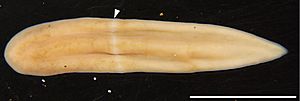Xenoturbella facts for kids
Quick facts for kids Xenoturbella |
|
|---|---|
 |
|
| Xenoturbella japonica | |
| Scientific classification | |
| Kingdom: | |
| Phylum: | |
| Subphylum: |
Xenoturbellida
Westblad, 1949
|
| Family: |
Xenoturbellidae
Westblad, 1949
|
| Genus: |
Xenoturbella
Westblad, 1949
|
Xenoturbella is a genus of bilaterian animals; it contains two marine worm-like species. The first known species was discovered in 1915 but was only described in 1949. A 2003 DNA study has shown it is a primitive deuterostome phylum. The genus was the first member of its subphylum (the Xenoturbellida) to be discovered.
This phylum is basal within the deuterostomes. It is related to the Acoelomorpha, forming a sister clade to the echinoderms and hemichordates. Other members of this phylum are now known.
Xenoturbella has a very simple body plan: it has no brain, no through gut, no excretory system, no organized gonads (but does have gametes), or any other organs except for a statocyst containing flagellated cells. It has cilia and a diffuse nervous system. The animal is up to 4 centimetres (1.6 in) long, and has been found off the coasts of Sweden, Scotland and Iceland.
The association of specimens of Xenoturbella with mollusc larva has led many to suggest that they are molluscivores. However, another idea is that the Xenoturbella larval stage develops as an internal parasite of certain molluscs.
The genus Xenoturbella contains two species:
- Xenoturbella bocki
- Xenoturbella westbladi
See also
 In Spanish: Xenoturbella para niños
In Spanish: Xenoturbella para niños

